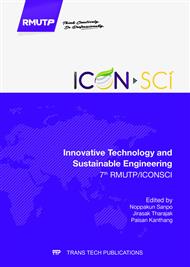p.156
p.160
p.164
p.168
p.172
p.176
p.183
p.187
p.191
Elemental Composition and Crystal Phases of Carbonized Spent Coffee Grounds
Abstract:
Spent coffee grounds (SCGs) are created in a large amount as a processing waste during making the coffee beverages. Due to its properties, this waste is attractive for different applications such as biofuel production, antioxidant capacity, and renewable materials. In this study, the SCGs were firstly washed by distilled water to remove impurities and contaminations. The washed SCGs were dried in an electric oven at 120 °C for 24 h. The dried SCGs were carbonized at various temperatures from 600-1400 °C for 4 h in normal atmosphere by electric furnace to produce the SCGs powders. The as-received powders were characterized to obtain composed elements and phases by Energy-dispersive X-ray spectroscopy (EDX/EDS) and X-ray diffraction (XRD), respectively. X-ray analysis results indicated that the obtained SCGs powders were dominated by carbon-rich phase with stronger bonding at higher carbonizing temperature. This finding was recommended that the SCGs could be considered as a possible candidate of the environmentally friendly materials to prepare and develop the biomass fuel generation.
Info:
Periodical:
Pages:
172-175
Citation:
Online since:
June 2017
Price:
Сopyright:
© 2017 Trans Tech Publications Ltd. All Rights Reserved
Share:
Citation:


